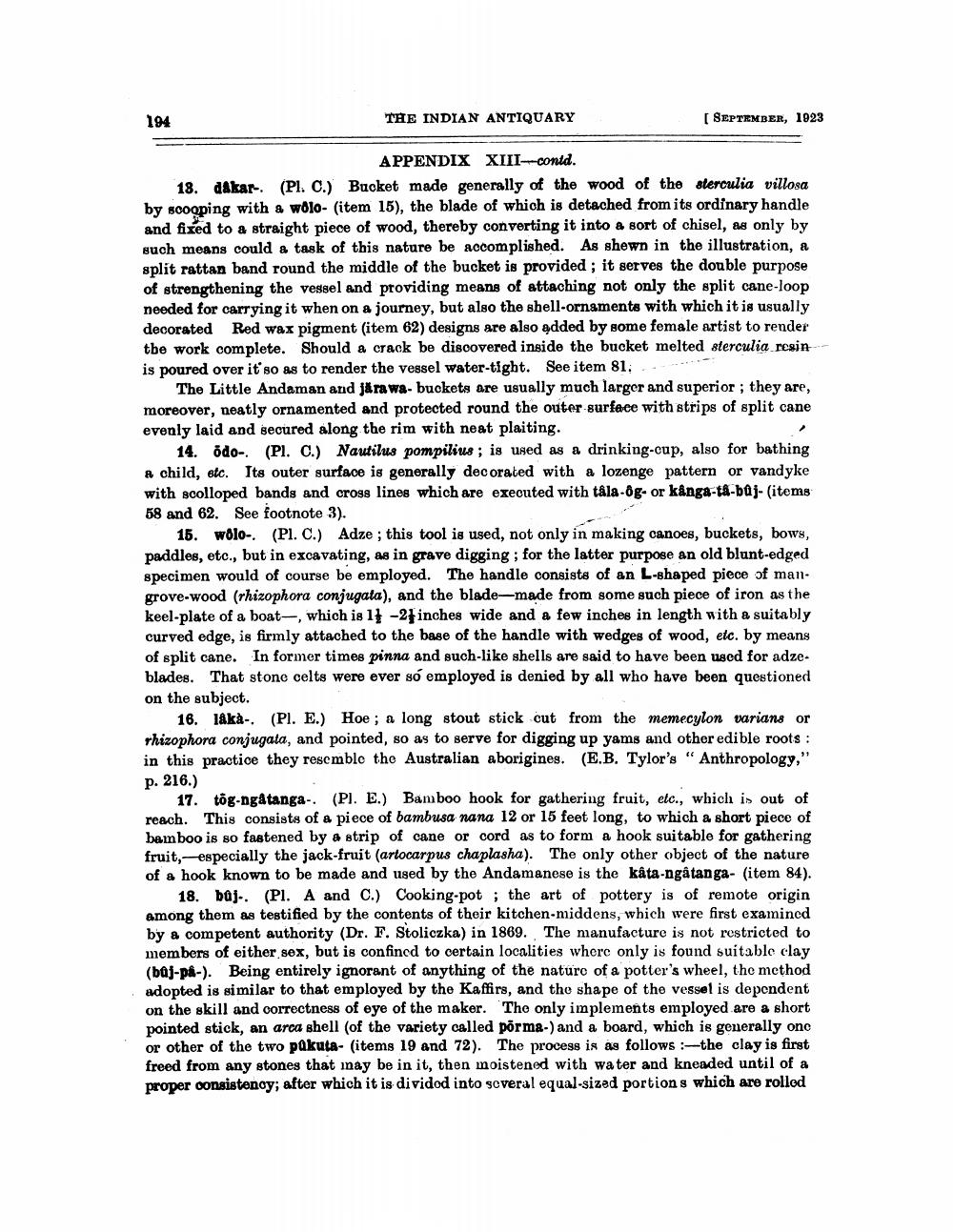________________
194
THE INDIAN ANTIQUARY
[ SEPTEMBER, 1923
APPENDIX XIII-contd. 18. dakar-. (Pl. C.) Bucket made generally of the wood of the sterculia villosa by scooping with a wolo- (item 15), the blade of which is detached from its ordinary handle and fixed to a straight piece of wood, thereby converting it into a sort of chisel, as only by auch means could a task of this nature be accomplished. As shewn in the illustration, a split rattan band round the middle of the bucket is provided; it serves the double purpose of strengthening the vessel and providing means of attaching not only the split cane-loop needed for carrying it when on a journey, but also the shell-ornaments with which it is usually decorated Red wax pigment (item 62) designs are also added by some female artist to render tbe work complete. Should a crack be discovered inside the bucket melted sterculia resin is poured over it' so as to render the vessel water-tight. See item 81...
The Little Andaman and jarawa- buckets are usually much larger and superior; they are, moreover, neatly ornamented and protected round the outer surface with strips of split cane evenly laid and secured along the rim with neat plaiting.
14. õdo-. (Pl. C.) Nautilus pompilius ; is used as a drinking-cup, also for bathing a child, etc. Its outer surface is generally decorated with a lozenge pattern or vandyke with scolloped bands and cross lines which are executed with tåla-og- or kanga-ta-baj- (items 58 and 62. See footnote 3).
15. wolo-. (Pl. C.) Adze ; this tool is used, not only in making canoes, buckets, bows, paddles, etc., but in excavating, as in grave digging ; for the latter purpose an old blunt-edged specimen would of course be employed. The handle consists of an L-shaped piece of man. grove-wood (rhizophora conjugata), and the blade-made from some such piece of iron as the keel-plate of a boat, which is 13 -24 inches wide and a few inches in length with a suitably curved edge, is firmly attached to the base of the handle with wedges of wood, etc. by means of split cane. In former times pinna and such-like shells are said to have been used for adzeblades. That stone celts were ever só employed is denied by all who have been questioned on the subject.
16. láka-. (PI. E.) Hoe; a long stout stick cut from the memecylon varians or Thizophora conjugata, and pointed, so as to serve for digging up yams and other edible roots : in this practice they resemble the Australian aborigines. (E.B. Tylor's "Anthropology," p. 216.)
17. tôg-ngâtanga-. (Pl. E.) Bamboo hook for gathering fruit, etc., which is out of reach. This consists of a piece of bambusa nana 12 or 15 feet long, to which & short piece of bamboo is so fastened by a strip of cane or cord as to form a hook suitable for gathering fruit, - especially the jack-fruit (artocarpus chaplasha). The only other object of the nature of a hook known to be made and used by the Andamanese is the kâta-ngatanga- (item 84).
18. boj.. (Pl. A and C.) Cooking-pot; the art of pottery is of remote origin among them as testified by the contents of their kitchen-middens, which were first examined by a competent authority (Dr. F. Stoliczka) in 1869. The manufacture is not restricted to members of either sex, but is confined to certain localities where only is found suitable clay (boj-på-). Being entirely ignorant of anything of the nature of a potter's wheel, the method adopted is similar to that employed by the Kaffirs, and the shape of the vessel is dependent on the skill and correctness of eye of the maker. The only implements employed are a short pointed stick, an arca shell (of the variety called põrma-) and a board, which is generally one or other of the two pakuta- (items 19 and 72). The process is as follows the clay is first freed from any stones that inay be in it, then moistened with water and kneaded until of a proper consistenoy, after which it is dividod into several equal-sized portions which are rolled




